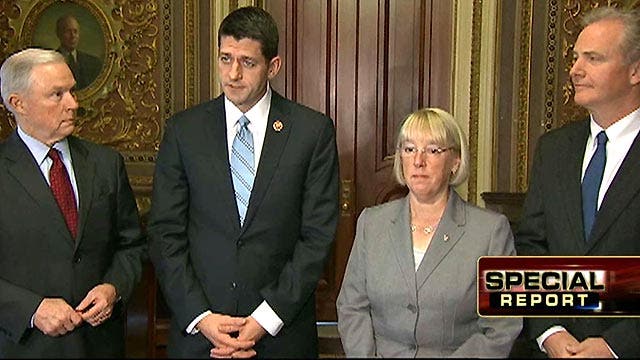Can budget conference committee find long-term solution?
Mike Emanuel reports from Capitol Hill
The good news: The national parks are open, furloughed federal workers are back on the job, and the country will not cut off benefit payments because it can't borrow.
The bad news: The national debt is back on course to hit $17 trillion any day now, with no deal in sight to ever reverse the climb.
The latest increase in the debt cap is the sixth since President Obama took office, when the debt was $10.6 trillion. It was raised three times when Democrats controlled Congress, and has been raised three times since Republicans took control of the House.
Fiscal conservatives and government watchdog groups reacted with dismay Thursday after Washington, following weeks of hard-nosed negotiations, produced only a stopgap bill to end the partial government shutdown and raise that cap. And despite the chaos of the past few weeks, they are once again trying to refocus Washington on the need to -- seriously -- lasso the nation's debt and break the habit of endless over-spending.
"Both houses should act quickly to stop the madness," said Maya MacGuineas, head of the Committee for a Responsible Budget and the Campaign to Fix the Debt. While voicing relief that the partial shutdown is over, she called the last-minute deal "incredibly disheartening," describing the debt as a "fire" that could "get out of control at any moment."
Republicans have been modestly emboldened in their push for spending cuts after the dire consequences that administration officials said would emerge from the so-called sequester, in large part, did not happen. Even the partial government shutdown had a limited impact on the country.
Obama, while urging both sides to come together on a new budget agreement in the coming weeks that addresses the nation's fiscal problems, on Thursday also downplayed the red ink.
"The deficit is getting smaller, not bigger," Obama said.
That's true. But, Sen. Marco Rubio, R-Fla., said: "You still have an unsustainable problem in place."
Since Obama took office, the total national debt has risen by nearly 60 percent. It was $10.6 trillion on the day he took office. It was $16.7 trillion when the nation technically hit the debt ceiling.
But, even during that period, the Treasury racked up another $200 billion in debt, borrowing from various U.S. funds to buy more time while Congress debated. As the New York Post explained Thursday, the debt is actually at $16.9 trillion.
So what do numbers so impossible to comprehend mean for the United States?
The nonpartisan Congressional Budget Office issued a rather dire warning last month about what the future holds if the trajectory is not changed.
The analysis explained how the government has been expanding at historic rates. Between 2009 and 2012, it said, deficits were larger relative to the size of the economy than at any point since 1946 -- in turn fueling the rapid growth in the debt.
Deficits are projected to fall for the next few years, but then rise again, in large part because of two major factors -- interest on the debt, and entitlement programs.
The growth of the debt has triggered a vicious cycle, where higher debt leads to bigger interest payments, in turn growing the debt even more.
The CBO estimates that by 2038, interest on the debt will rise to 5 percent of GDP -- compared against a modern historical average of 2 percent. That means less money in the federal coffers for everything from the military to benefits programs.
But the biggest benefits programs, known in Washington as entitlements, are the dominant factor.
Programs like Medicare, Medicaid and Social Security are poised to eat up more and more of the federal budget. The CBO says the share of spending on those programs will double by 2038, to 14 percent of GDP. As a consequence, spending on everything else will drop.
Obama said Thursday that longer-term deficits do need to be addressed, and that budget negotiators need to focus on programs like Medicare and Social Security.
But Rubio said the problem is Obama has resisted major changes to any of those programs, due in part to resistance from the liberal base.





